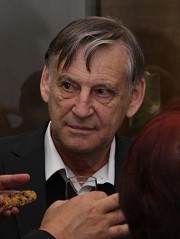This month, we talk dynamic semantics with Hans Kamp, Visiting Professor of Philosophy at the University of Texas at Austin and Senior Research Fellow at the Institute for Natural Language Processing in Stuttgart. Click here to listen to our conversation.
 The goal of formal semantics is to explain how the meaning of a whole sentence is derived from the words that make it up and the way they’re put together. Give me some definitions of individual words, tell me the order in which they were combined, and by means of a mechanical algorithm, my theory will predict what the resulting sentence means.
The goal of formal semantics is to explain how the meaning of a whole sentence is derived from the words that make it up and the way they’re put together. Give me some definitions of individual words, tell me the order in which they were combined, and by means of a mechanical algorithm, my theory will predict what the resulting sentence means.
Traditionally, philosophers have thought of sentence meaning as a self-contained thing. If I say, ‘The plane has arrived,’ then you can think of what I’m doing as painting a hypothetical picture in which a plane arrives, inviting you to hold the world up next to it in your imagination, then saying, ‘See? This is the way the world is.’
But if we adopt this conception of sentence meaning, it isn’t clear how to make sense of what happens when sentences interact with one another. After all, the meaning of what we say often depends on what we said earlier. For example, imagine you’re reading a novel, and it opens with one of these two sentence pairs:
(1) A lawyer approached the bench. She sighed.
(2) She sighed. A lawyer approached the bench.
The second pair would be exceedingly weird. Why? Because it’s unclear who ‘she’ is supposed to refer to. The first pair, on the other hand, would be perfectly fine, because it’s clear in that context that ‘she’ refers to the lawyer mentioned in the first sentence.
Now, there is a lot going on in this example, but the main take-home moral is that the process of interpreting the second sentence in (1) has to reach back, as it were, to the first sentence. Otherwise the second sentence can’t be interpreted. Allowing the process of interpretation to reach back in this way requires that we revise our conception of what sentence meaning is: the meaning of a sentence can no longer be thought of as a picture of a hypothetical scenario. Rather, it must be something more abstract.
The influential answer that Hans Kamp proposed to this problem in the 1980s was that a sentence can be thought of as a way of transforming conversational context. And the formal framework he developed to give precise expression to this idea is called discourse representation theory, or DRT for short.
Join us as Hans Kamp gives us a tour through DRT!
Matt Teichman
Leave a Reply